RUNNING →
Level Up Your Nutrition Game With Our Freebies
Alex
I provide nutrition coaching for endurance athletes to improve performance and body composition through a simple and flexible eating style.
Hi, I'm
ATHLETE EATING GUIDE →
PROTEIN →
TRIATHLON →
RECIPES →
PERFORMANCE NUTRITION →
SUPPLEMENTS →
HOLIDAY & TRAVEL →
PLANT-BASED →
FEMALE ATHLETE NUTRITION
Explore the Blog
LEARN MORE →
ATHLETE GROCERY SHOPPING GUIDE →
RACE DAY: TRIATHLON NUTRITION PLANNER →
READY TO FUEL?
incredible value!
The fueling guide bundle serves as your one-stop-shop for strategies to fueling before, during and after your workouts.
ENDURANCE EATS
BINGE-WATCH READY!
YOUTUBE SERIES
When it comes to optimizing performance and supporting recovery, energy bars for runners have become a staple. These convenient and portable snacks offer a quick and sustained source of energy, making them a go-to choice for athletes of all levels.
In this article, we will delve into the reasons why energy bars for runners are popular, their purpose in providing the necessary fuel, and how they contribute to performance and recovery. We will also explore the key nutrients found in energy bars, provide tips for choosing the right one, discuss ways to incorporate them into your running routine, and address specific considerations for endurance runners. By the end of this article, you’ll be equipped with the knowledge to make informed choices when selecting and utilizing energy bars.
The Role of Energy Bars for Runners
Energy bars have gained significant popularity among runners for various reasons. These include their convenience, portability, and the ability to provide a quick source of fuel on the go in a wide variety of flavors and textures. Energy bars offer a practical solution, allowing runners to fuel their bodies effectively and conveniently.
The primary purpose of energy bars is to provide runners with a quick and sustained source of energy. The carbohydrates in energy bars are particularly important as they serve as the primary fuel source for endurance activities, supplying the body with readily available energy to sustain performance.

Key Nutrients in Energy Bars for Runners
Energy bars for runners will vary in their combination of macronutrients.
Carbohydrates are the primary source of fuel for running, supplying the muscles with readily available energy. Proteins aid in muscle repair and recovery, while fats provide a sustained source of energy and help regulate hormone production.
Selecting the right energy bar is essential for maximizing the benefits and meeting your individual needs as a runner. Consider factors such as ingredient quality, macronutrient composition, taste preferences, and any specific dietary restrictions or preferences you may have.
Reading the nutrition label and ingredient list is crucial to ensure that the energy bar aligns with your goals and provides the necessary nutrition for when you’re consuming it.
Energy Bars for Runners: Considerations for Workouts
Pre-workout/pre-race
Since carbohydrates are going to fuel your body for the upcoming exercise look for a bar with higher carb content. Aim for bars lower in fat and fiber as they will slow the length of time it takes to digest. If there’s a little protein in it that’s ok.
During Exercise
Choose a bar that’s made up of easy-to-digest carbohydrate sources. Look for energy bars that are lower in fat, fiber and protein. You’ll want to trial different bars during your training so you know what your body will tolerate best for race day. With trail running or cycling, usually energy bars that have some fat content from nut butters tend to be tolerated fairly well, but it can vary from athlete to athlete.
Post-workout/post-race
Look for a ratio of 3-4:1 ratio of carbs-to-protein. A mega-dose of protein from an energy bar isn’t going to give you an edge. Plus, the higher the concentration of protein the more likely it’s going to not taste very good. Most bars aren’t going to supply all of your post-recovery nutrition needs so best to pair it with additional carbs, protein (and hydration).
Meal replacement {red flag!}
Energy bars shouldn’t be treated as a replacement for a meal during your normal every day. They should be treated as a convenient, pre-wrapped item, a snack. Make sure you’re including some real foods via meals and snacks throughout your day.
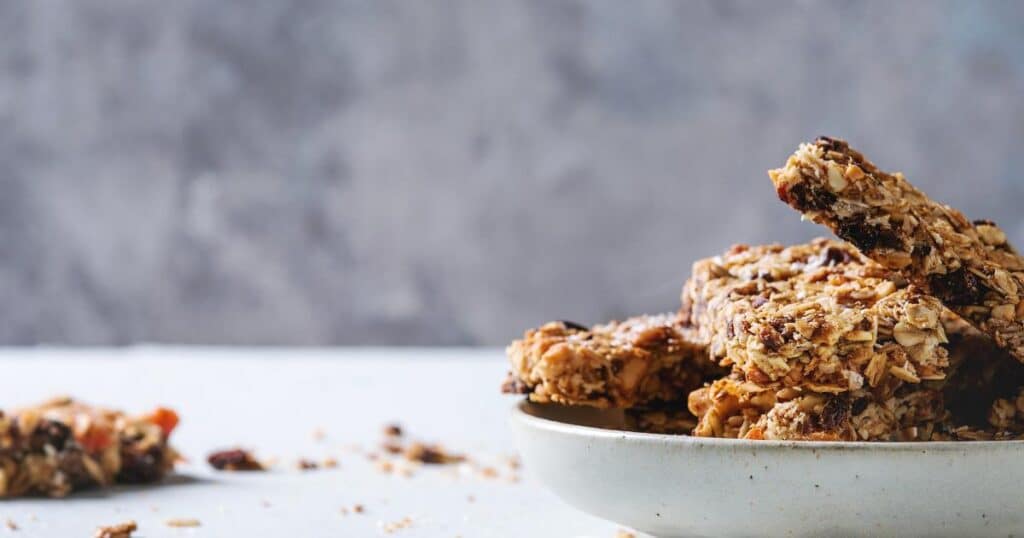
Ingredients to Avoid
While it can vary in what athletes can tolerate for foods and ingredients, there are certain ingredients that we typically are wary of for athletes. GI issues during exercise certainly aren’t uncommon, so it’s important to be cautious when choosing an energy bar. Here are a few ingredients to look out for:
- Added fibers such as inulin and chicory root powder.
- Sugar alcohols, such as mannitol, erythritol, sorbitol, maltitol, xylitol, lactitol, isomalt.
- Artificial sweeteners, some athletes can be sensitive to these.
Dietitians’ Review Popular Energy Bars for Runners
My dietitian team and I love shopping for fueling products (our fave is ordering from TheFeed.com because the sell single servings of fuel products), taste testing, analyzing nutrient profiles and ingredients and sharing our recommendations to our athletes in the 1:1 nutrition coaching program. So here is a selection of popular energy bars that we’ve analyzed and reviewed with endurance athletes in mind.
Maurten Solid 225 Energy Bar

Nutrition Per bar: 225 calories, 3.6 g fat, 260 mg sodium, 42 g carbs, 1.8 g fiber, 2.5 g protein, 0 mg caffeine
Average cost: $3 per bar
Most energy bars are made as a snack option, but Maurten created these specifically as a high-performance fuel option with 42 g carbs per bar and 260 mg of sodium. They are easy to chew and eat while exercising hard. At a pricey $3 per bar, it’s a product I’d only use strategically to fuel workouts and races instead of for daily snacking.
Our Dietitians Say:
“What I like about the 225 bars: honestly everything. The taste, texture are perfect and such an easy bar to use in a carb load or during a race. Especially for trail runners and cyclists; probably not so much for road runners. What I don’t like is the price and I do think that some athletes may find them too sweet.”
-Dietitian Mary
“Enjoy the texture. They are not too crunchy or messy, nor are they overly chewy, plus the macros are wonderful!”
-Dietitian Hanna
Skratch Labs Anytime Energy Bars
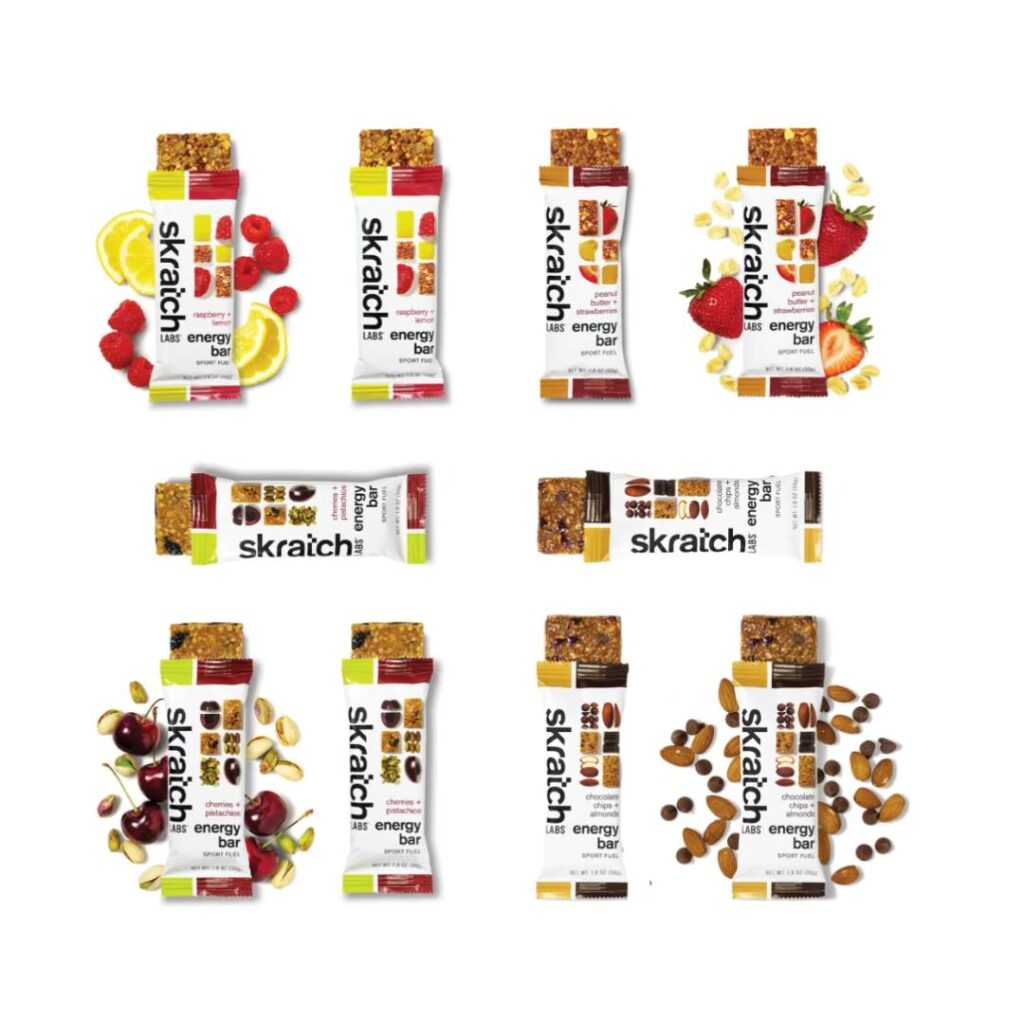
Nutrition per bar (varies among flavors): 200-250 calories, 13-14 g fat, 105-210 mg sodium, 30-34 g carbs, 2-3 g fiber, 4-5 g protein
Average cost: ~$2.50 per bar
Due to the nut butter blend as the main ingredient, this bar is higher in fat than what I’d like to see for athletes and runners using before and during exercise. I’d recommend this more for hiking or bike riding where your effort level is lower and athletes can tolerate a higher-fat fuel product better. They offer both sweet and savory flavors.
Gluten-Free, Plant-Based Friendly
Bobo Bars
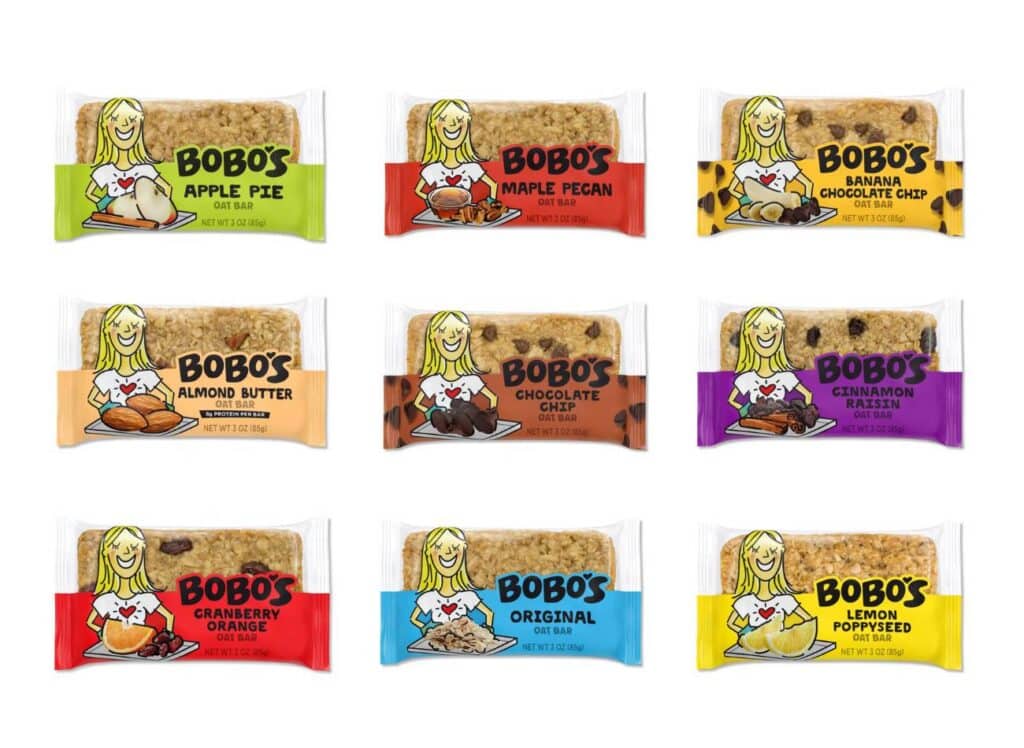
Nutrition per bar: 340 calories, 12 g fat, 150 mg sodium, 62 g carbs, 4 g fiber, 6 g protein
Average cost: about $3 per bar
These are very calorie and carb dense. I could see these being a great option pre-workout/pre-race to get a solid dose of energy. Or, snacked on slowly during a trail run or long cycle. It has more of dense, baked good feel to it. They come in a wide variety of flavors!
Betty Lou’s Bars
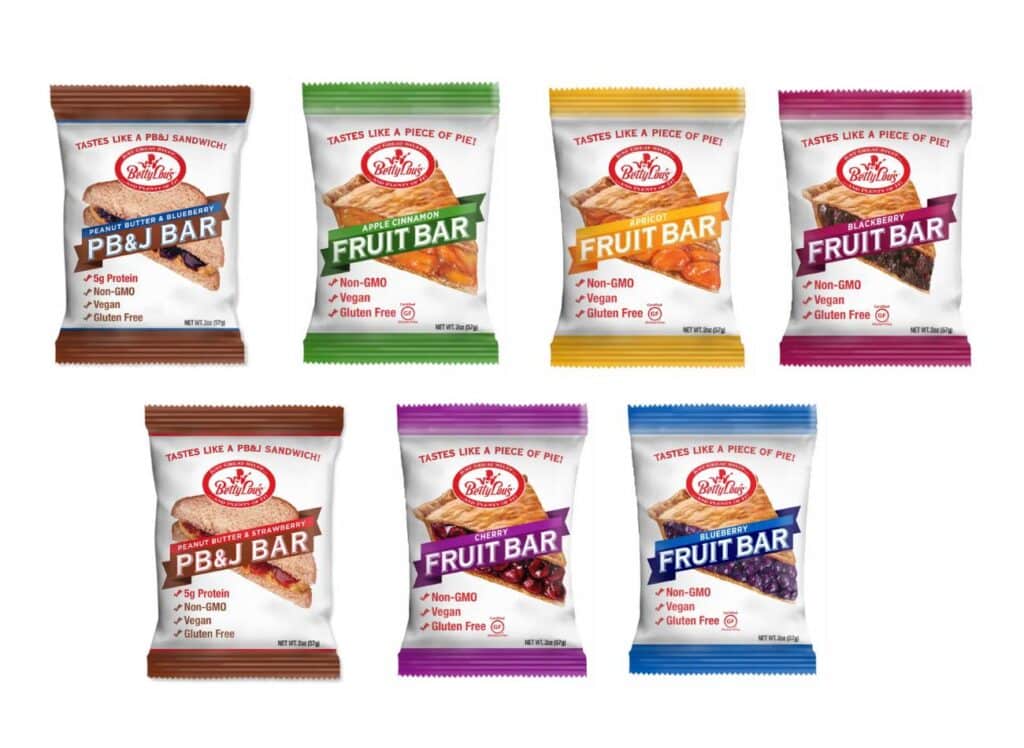
Nutrition per fruit bar: 200 calories, 3 g fat, 85 mg sodium, 42 g carbs, 2 g fiber, 1 g protein
Nutrition per PB&J bar: 220 calories, 6 g fat, 160 mg sodium, 36 g carbs, 3 g fiber, 5 g protein
Average cost: $2.16 per bar
Craving a piece of pie? Enjoy a PB&J sandwich? That’s essentially what Betty Lou converted into a bar. I love the high-carb content of the fruit bar, though it’s not going to provide a decent dose of sodium for the salty sweating athletes.
Gluten-Free, Nut-Free and Plant-Based Friendly
Our Dietitians Say:
“These were sooooooooo freaking good.”
– Dietitian Mary
“I’ve tried these! Love love!”
– Dietitian Hanna
Clif Bars
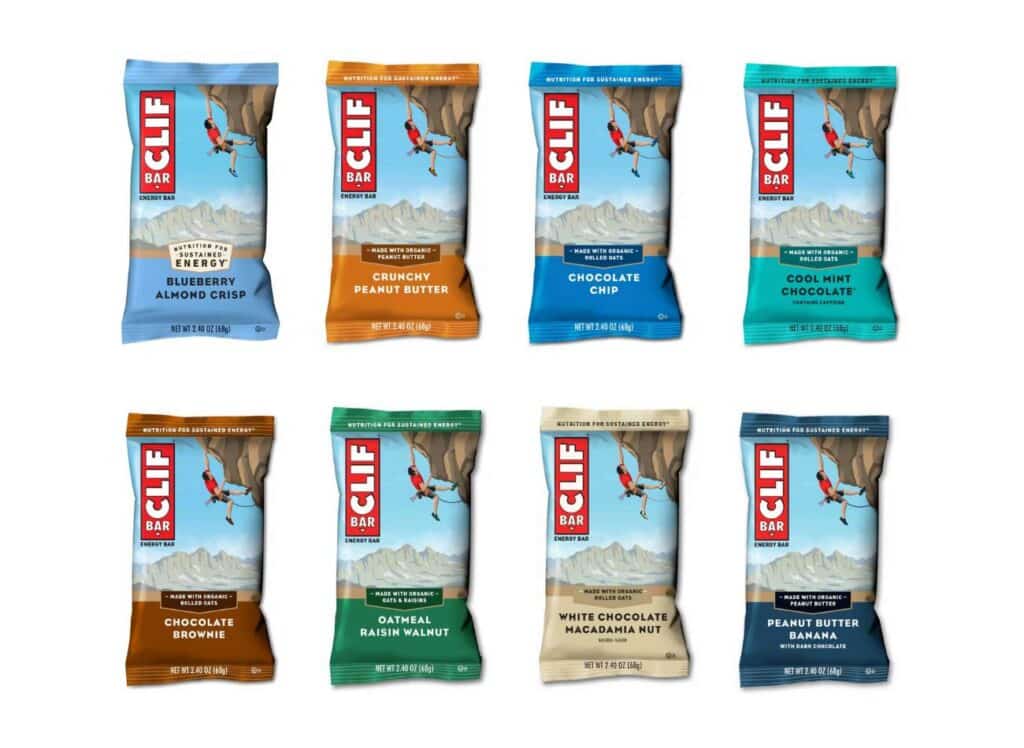
Average Nutrition per bar (will vary among flavors): 250 calories, 6 g fat, 140 mg sodium, 43 g carbohydrates, 5 g fiber, 10 g protein.
Average cost: $1.50-2.00
While these are definitely one of the most popular and affordable bars compared to others we’ve reviewed, the Clif bars fits better into the snack bar category than it does for performance fueling. While it has a high dose of carbohydrates, the protein, fat and fiber content concern me that it may cause GI issues in runners. Especially with the ingredient chicory fiber included in these bars, which is known for being gas producing. Clif Bars would be a better fit for post-workout than before or during.
Our Dietitians Say:
“I personally wouldn’t use these around my workouts, due to the likelihood of sh*tting my pants. I think it’s contingent on how strong (or not) an athlete’s gut is.”
– Dietitian Mary
“They have a good amount of carbs, are inexpensive and easy to find most places. But personally wouldn’t use to fuel workouts.”
– Dietitian Hanna
Picky Bars

Nutrition per bar (based on Ah, Fudge Nuts flavor): 190 calories, 8 g fat, 100 mg sodium, 24 g carbs, 3 g fiber, 7 g protein.
Average cost: $2.75 per bar
If you’re looking for a bar that has real food ingredients, Picky Bars would fit that well. Nutritionally, we’d recommend these for a post-workout snack. However, they likely would need to be paired with additional carbs and proteins to meet post-recovery nutrition needs.
Gluten-Free
Our Dietitians Say:
“I’ve tried these and like them!”
– Dietitian Hanna
Bonk Breaker Energy Bars

Nutrition per bar (varies among flavors): 200-270 calories, 8-10 g fat, 50-120 mtg sodium, 3 g fiber, 6-8 g protein.
Average cost: $2.50 per bar
Bonk Breaker energy bars are limited in flavors (there is more variety in their protein bars).
Gluten-free, Dairy-Free, Plant-Based Friendly
NEVERSECOND C30 Bars
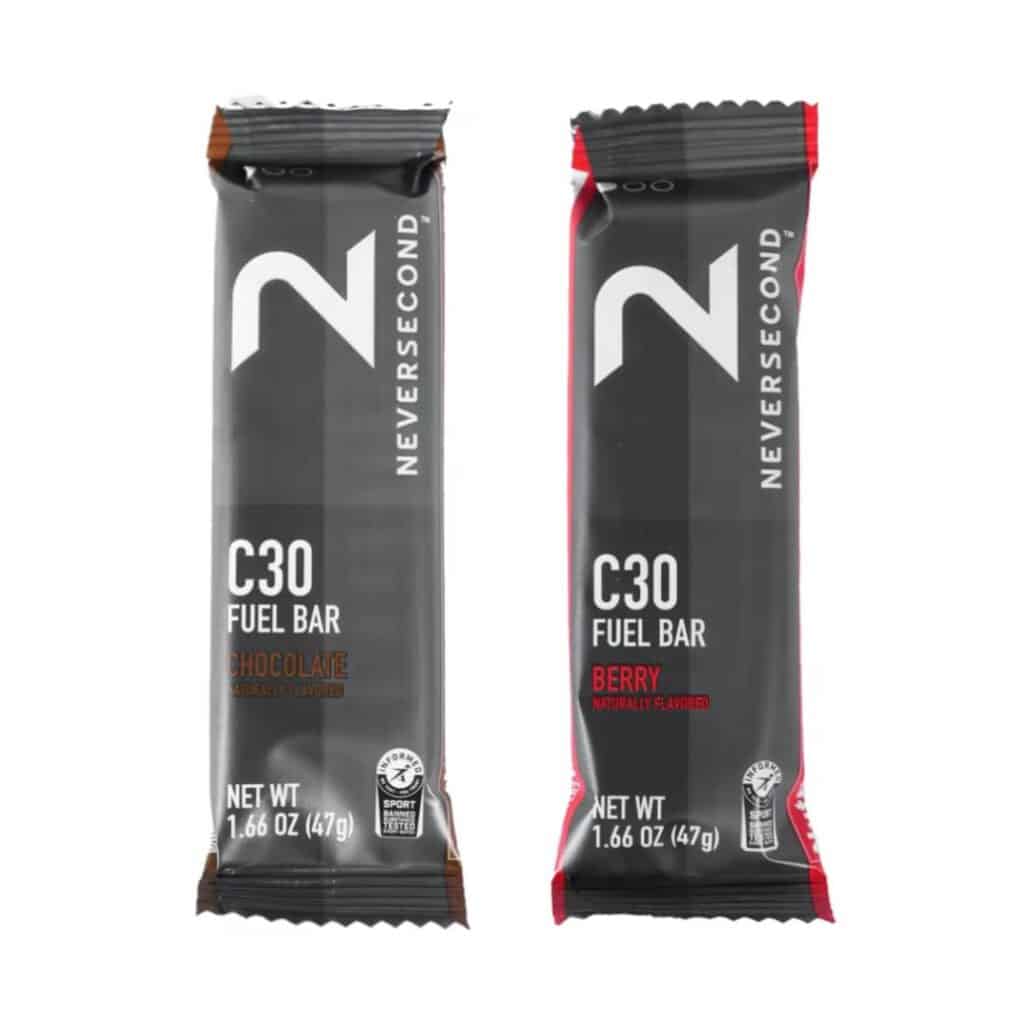
Nutrition per bar: 180 calories, 5 g fat, 30 mg sodium, 30 g carbs, 2 g fiber, 3 g protein.
Average cost: $3.50 per bar
These were a newer product on the market so adding them to our list. They definitely were designed to be a true energy bar for during-exercise performance. They remind me of Lara Bars with their base being made of dates. These are the priciest of all the bars we’ve reviewed. So does the nutritional value match the cost? While I like the nutrient profile of these, they lack the higher carb and sodium content, 42 g and 210 mg respectively, of Maurten’s Solid 225 (that has a $3/bar price tag).
Plant-Based Friendly
Make Your Own Homemade Energy Fuel
It’s certainly do-able to use homemade granola bars and foods to help fuel your workouts. Here are a few recipes available on the ALN blog that we enjoy using!
Easy No-Bake Peanut Butter Oatmeal Balls – Ideal for post-workout
Easy Oatmeal Bake – Pre- or post-workout, this oatmeal bake is delicious!
Protein Snack Pack Ideas – There is a high-protein trail mix recipe here that is perfect when you need an on-the-go post-workout snack!
The Best Pancakes! – This pancake recipe is made weekly in Alex’s house, and they are her favorite to have Saturday mornings before her long runs. These are a must-try!
The Takeaway
Between gels, energy chews, energy bars, carb-based hydration mixes, athletes have a wonder of options when it comes to fueling their workouts and runs. It can be overwhelming where to start and what to choose.
If you want help dialing in your fueling, reach out and let my team help take the guesswork out of the process and make sure you can maximize your time training. We accept new athlete clients all-year round in the 1:1 nutrition coaching program. We are here whenever you’re ready!
Alex
I provide nutrition coaching for endurance athletes to improve performance and body composition through a simple and flexible eating style.
Hi, I'm
LEARN MORE →
take the quiz!
Let's discover your Endurance Nutrition IQ
How well do you know your fueling? Answer these questions and let's see where your endurance nutrition knowledge is at!
Take the quiz
level up your nutrition game with these freebies
free downloadS
Protein-Packed 10-Day Sample Meal Plan
Athlete Eating Guide
Athlete Grocery Shopping Guide
1
2
3
Inspiration to fit 120 grams of protein into your day
Planning what goes on your plate
Putting the right foods in your grocery cart
